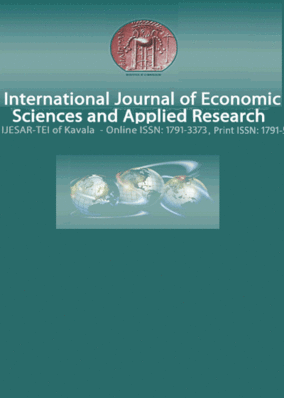The impact of the recent global crisis on the prioritization of central banks final objectives : A structural approach in the context of Central and Eastern European states
Part of : International Journal of Business and Economic Sciences Applied Research ; Vol.7, No.2, 2014, pages 51-76
Issue:
Pages:
51-76
Author:
Abstract:
This paper aims to identify the actual objectives of monetary authorities in Central and Eastern Europe (CEE) that promote an independent monetary policy. In this sense we consider the study of central banks (CBs) behavior in the Czech Republic, Poland, Romania and Hungary in establishing short-term nominal interest rate by estimating a Taylor-type monetary policy rule, with new features in terms of elements aimed at exploring the interactions between the monetary policy andfinancial stability. We estimate the monetary policy rule based on a dynamic stochastic general equilibrium model (DSGE). The main results revealed the strong stance of the selected monetary authorities towards their fundamental objective of price stability, but in parallel, towards stabilizing the exchange rate and real economic activity and the existence of specific elements indicating a leaning against the wind orientation of the monetary policy in countries under analysis. Following the emergence of international turmoil our analysis has identified the maintaining of a strong orientation towards the primary objective of monetary policy, a similar relative stance of monetary’policy relative to the stabilization of the real activity alongside a decrease in the focus of stabilizing the exchange rate, while the accentuated focus on financial stability does not appear to be achieved through monetary policy.
Subject:
Keywords:
DSGE models, Taylor rules, monetary policy, Bayesian methods, Central and Eastern Europe
Notes:
JEL Classification: C11, E52, F41, Περιέχει πίνακες, βιβλιογραφία και παράρτημα
References (1):
- An, S. and Schorfheide, F., 2007, ‘Bayesian analysis of DSGE models’, Econometric Reviews, 26, 2, pp. 113-172.Andrle, M., Hlédik, T., Kamenik, O. and Vlcek, J., 2009, ‘Implementing the New Structural Model of the Czech National Bank’, Czech National Bank Working Paper 2.Angeloni, I., Flad, M. and Mongelli, F., R, 2007, ‘Monetary integration of the new EU Member States: what sets the pace of Euro adoption?’, Journal of Common Market Studies, 45, 2, pp. 367-409.Clarida, R., Gali, J. and Gertler, M., 1998, ‘Monetary Policy Rules in Practice: Some International Evidence’, European Economic Review, 42, pp. 1033-1067.Copaciu, M., 2013, ‘Estimations of an Open economy DSGE Model with Fianancial and Employment Frictions for Romania’, manuscript.Caraiani, R, 2008, ‘An Analysis of Domestic and External Shocks on Romanian Economy Using a DSGE Model’, Romanian Journal of Economic Forecasting, 3, pp. 100-114.Caraiani, R, 2011a, ‘Comparing Monetary Policy Rules for Romania: A New Keynesian Approach’, Romanian Journal of Economic Forecasting, 4, pp. 30-46.Caraiani, R, 2011b, ‘Fiscal Policy in CEE Countries. Evidence from Czech Republic and Romania’, Econimicky Casopis, 59, 1, pp. 79-104.Caraiani, R, 2013, ‘Comparing Monetary Policy Rules in CEE Economies: A Bayesian Approach’, Economic Modelling, 32, pp. 233-246.Eschenhof, S., 2009, ‘Comparing Monetary Policy Rules in a Small Open Economy Framework: An Empirical Analysis Using Bayesian Techniques’, Darmstadt University of Technology, Discussion Papers in Economics, 197.Frömmel, M. and Schobert, F., 2006, ‘Monetary Policy Rules in Central and Eastern Europe’, University of Hannover Discussion Paper, 341.Frömmel, M., Garabedian, G. and Schobert, F., 2011, ‘Monetary policy rules in Central and Eastern European Countries: Does the exchange rate matter?’, Journal of Macroeconomics, 33, pp. 807-818.Gali, J. and Monacelli, T., 2005, ‘Monetary Policy and Exchange Rate Volatility in a Small Open Economy’, Review of Economic Studies, 72, pp. 707-734.Grabek, G., Klos, B. and Koloch, G., 2011, ‘SOE PL (2009J An Estimated Dynamic Stochastic General Equilibrium Model for Policy Analysis And Forecasting’, National Bank of Poland Working Paper, 83.Griffoli, T., M., 2008, ‘An introduction to the solution & estimation of DSGE models’, DYNARE User Guide, http://www.dynare.org, (accessed 5/8/2013).Juillard, M., 1996, ‘Dynare: A Program for the Resolution and Simulation of Dynamic Models with Forward Variables through the Use of a Relaxation Algorithm’, CEP REMAP Working Paper, 9602.Juillard, M., 2004, ‘DYNARE: A Program for Simulating and Estimating DSGE Models’, http://www.cepremap.cnrs.fr/dynare/, (accessed 15/8/2013).Lubik, T. and Schorfheide, F., 2007, ‘Do Central Banks Respond to Exchange Rate Movements? A Structural Investigation’, Journal of Monetary Economics, 54, 4, pp. 1069-1087.Maria-Dolores, R., 2005, ‘Monetary Policy Rules in Accession Countries to EU: IS Taylor rule a pattern?’, Economics Bulletin, 5, 5, pp. 1-16.Munoz, F. and Schmidt-Hebbel, K., 2012, ‘Do the World’s Central Banks React to Financial Markets?’ in Financial Deepening, Macro-Stability and Growth in Developing Countries, (Washington: International Monetary Fund).Orlowski, L., T., 2008, ‘Monetary Policy Rules for Convergence to the Euro’, Center for Social and Economic Research, Warsaw, CASE Network Studies & Analyses, 358.Orlowski, L., T., 2010, ‘Monetary Policy Rules for Convergence to the Euro’, Economic Systems, 34, pp. 148-159.Paez-Farell, J., 2007, ‘Understanding monetary policy in central european countries using Taylor-type rules: the case of the Visegrad four’, Economics Bulletin, 5, 3, pp. 1-11.Szilâgyi, K., Baksa, D., Benes, J., Horvath, A., Kôber, C. and Soôs, G., D., 2013, ‘The Hungarian Monetary Policy Model’, Magyar Nemzeti Bank Working Paper, 1.Vasicek, B., 2008, ‘Monetary policy rules and inflation process in open emerging economies: evidence for 12 new EU members’, William Davidson Institute Working Paper, 968.




